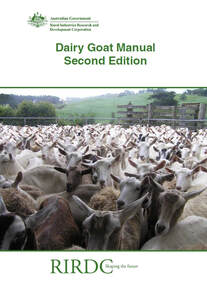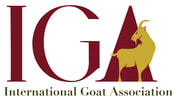 Are you a bovine or companion animal veterinarian interested in working with local dairy goat producers but need to brush up on your caprine knowledge? Maybe you own dairy goats and want to take your herd health and milk quality to the next level? The American Association of Small Ruminant Practitioners has a podcast for you!
0 Comments
 Contribution of small ruminants to food security for Ethiopian smallholder farmers Volume 184, March 2020, 106064 Hiwot Desta Wodajo, Biruk Alemu Gemeda, Wole Kinati, Annet Abenakyo Mulem, Anouka van Eerdewijk, Barbara Wieland Abstract This study investigates how and to what extent arguments related to food security influence preference of livestock species for women and men. Data was collected in four regions of Ethiopia through 92 focus group discussions (FGD) in communities where small ruminant production is common, Using a gender sensitive study designs, 23 FGDs were held separately with men, women and youth (male and female), and through a household survey involving 217 male and 212 women. Qualitative analysis was conducted to extract reasons given to explain the importance of livestock. Reasons related to food security were mapped to the four dimensions underpinning food security—accessibility, availability, nutritional value and stability. All FGDs considered sheep the most important livestock species, followed by cattle, with women allocating higher scores to sheep than men. All four dimensions of food security came up in statements explaining the importance of species but with variations across species. Interestingly, food security related arguments were most prevalent for goats followed by poultry. Of reasons given by women concerning the importance of goats, 78 % were related to food security with all four dimensions represented, and 52 % for poultry with two dimensions (availability and nutritional value). Answers from men especially had a stronger focus on economic reasons directly linked to income generation. Nevertheless, 64 % of men’s arguments for goats were related to food security. For sheep however, women only scored higher for arguments related to availability. When investigating purpose of small ruminant production at household level through a household survey, the importance of small ruminants for food security were confirmed; however, gender differences were less apparent. Being able to sell animals at short notice was the main reason for keeping small ruminants for both women and men followed by meat and milk for home consumption. Women’s argument for prioritizing selling were accessibility. For men, key arguments for selling were related to availability. For meat and milk their nutritional value was an important argument. Comparing agroecologies, accessibility (selling) was ranked top in highland areas and nutritional value (milk) was most important in lowland areas. In conclusion, this study provides much needed evidence on how small ruminants contribute to different dimensions of food security and are promising entry points targeting women to improve food and nutritional security by providing adequate animal source foods in a household. To read the entire article, visit SRR  by Gaille Abud (IGA member) and Arthur Stubbs Foreword This revised edition of the “Dairy Goat Manual” was compiled as a guide to current recommended dairy goat farm management practices based on observations and information gained during the course of the RIRDC project “Farming and Marketing Goat and Sheep Milk Products”. Information contained in this Manual is provided as general advice only. For application to specific situations, professional advice should be sought. RIRDC and its research agents have taken all reasonable steps to ensure that the information in these publications is accurate at the time of publication. Readers should ensure that they make appropriate enquiries to determine whether new information is available on the particular subject matter. The project was funded from RIRDC Core Funds which are provided by the Australian Government. This report, an addition to RIRDC’s diverse range of over 1800 research publications, forms part of our New Animal Products R&D program, which aims to accelerate the development of viable new animal industries. Most of our publications are available for viewing, downloading or purchasing online through our website:
Peter O’Brien Managing Director Rural Industries Research and Development Corporation  Registration and Abstract submission are now open! Early registration is available until June 30th. Register here. To download the abstract form file, click here. Program The meeting is structured in six main presentations (45+15 minutes), oral presentations (10+5 minutes), and poster presentations during the three days. Awards will be given for the best oral and poster presentations by young scientists. Visit the meeting website for more information, including hotel recommendations https://colostrum.ulpgc.es 8th IDF International Symposium on sheep, goat and other non-cow milk, May 4-5, 2020, Belgium1/18/2020 IDF is bringing together the global dairy community to focus on “Sheep, Goat and other non-Cow milk” in Brussels.
Sheep, goats and other non-cow milk producing animals are widely distributed throughout the world. They contribute to sustainable livelihoods through support of the economy, rural and peri-urban livelihoods, the empowerment of women, and food security. Find out more at the symposium's website: https://www.fil-idf.org/sheepandgoat2020/ The bacterium Lactobacillus rhamnosus EM 1107, used in the production of goat milk cheese, was able to survive the digestive process and to control intestinal inflammatory responses. This was the research carried out at the Federal University of Paraíba (UFPB) in partnership with Embrapa and published in the Journal of Functional Foods.
The microorganism is one of the isolates of dairy products of the Caatinga that are studied by Embrapa Goats and Sheep (EC) and partner institutions to be ingredients of dairy products beneficial to health. Among them, a 100% national goat cheese that will have this bacterium in its composition and that is already being tested in the dairy of the Carnaúba Farm, in Taperoá, Paraíba. READ MORE… A bactéria Lactobacillus rhamnosus EM 1107, empregada na produção de queijo de leite de cabra, apresentou capacidade de sobreviver ao processo digestivo e controlar respostas inflamatórias intestinais. Foi o que mostrou pesquisa executada na Universidade Federal da Paraíba (UFPB) em parceria com a Embrapa e publicada na revista Journal of Functional Foods.
O microrganismo é um dos isolados de produtos lácteos da Caatinga que são estudados pela Embrapa Caprinos e Ovinos (CE) e instituições parceiras para serem ingredientes de produtos lácteos benéficos à saúde. Entre eles, um queijo caprino 100% nacional que terá essa bactéria em sua composição e que já está sendo testado no laticínio da Fazenda Carnaúba, em Taperoá, na Paraíba. CONSULTE MAIS INFORMAÇÃO… Yogurt has deep roots in Ethiopia, particularly for pastoral communities, and now its handling is facing deep scrutiny from a research team at Addis Ababa University (AAU). Led by Dr. Kebede Amenu, the team is using bacterial counts to compare the safety of yogurt stored in aluminum containers versus traditional yogurt containers that women treat with a smoking process for sanitation. The team carried out a lab-based experiment to assess the effect of smoking of containers using different tree species on the microbial load of milk and yogurt kept in smoked containers. Building its case, the milk safety project collected milk and feces from 217 cows and camels in May and completed microbiological analysis for E.coli O157 and Salmonella. Comparing the results of this analysis to that on microbes present in the containers will help to determine the efficiency of the sanitation process. Ultimately, Dr. Amenu hopes to improve the sanitation of dairy products in remote parts of Ethiopia. The project, as summarized in this blog post, supports women and families to overcome food insecurity. It also funds three master’s students.
 The Latvian Goat Society (Latvijas Kazkopības Biedrība) was established in 2006. Our aim is to make goat breeding more popular in Latvia, to unite goat breeders as well as offer a wider variety of goat breeds for Latvian breeders. Our main tasks include providing services of pedigree and popularizing goat breeding in Latvia and around the world. The LGS works on two pedigree programs:
Comparison of milk fatty acid profile obtained from goats fed with different dry forage speciesLucia Sepe, Maria Antonietta Di Napoli, Salvatore Claps, Adriana Di Trana Fat in milk and dairy products gives an important contribution to consumption of essential fatty acids and vitamins in the human diet, and play a critical role in the sensory attributes of these foods [Dewhurst et al., 2006]
Milk fat contains a number of FA shown to exert anti-carcinogenic, hypocholesterolaemic and anti-inflammatory properties, including butyric acid (C4:0), oleic acid (cis-9 18:1), conjugated linoleic acid (CLA), linoleic acid (LA, 18:2 n-6) and α-Linoleic acid (ALA, 18:3 n-3) [Williams, 2000]. |
IGA Blog
The International Goat Association promotes goat research and development for the benefit of humankind, to alleviate poverty, to promote prosperity and to improve the quality of life. Archives
May 2024
Categories
All
|
|
International Goat Association
2516 Millbrook Rd., Little Rock, AR72227 USA email: [email protected] -454-1641 |


 RSS Feed
RSS Feed